The Red Scare
Printed Page 668
Suppression of labor strikes was one response to the widespread fear of internal subversion that swept the nation in 1919. The Red scare (“Red” referred to the color of the Bolshevik flag) had homegrown causes: the postwar recession, labor unrest, terrorist acts, and the difficulties of reintegrating millions of returning veterans. But unsettling events abroad also added to Americans’ anxieties.
 The widespread fear of internal subversion and Communist revolution that swept the United States in 1919 and resulted in suppression of dissent. Labor unrest, postwar recession, the difficult peacetime readjustment, and the Soviet establishment of the Comintern all contributed to the scare.
The widespread fear of internal subversion and Communist revolution that swept the United States in 1919 and resulted in suppression of dissent. Labor unrest, postwar recession, the difficult peacetime readjustment, and the Soviet establishment of the Comintern all contributed to the scare.
Two epidemics swept the globe in 1918. One was Spanish influenza, which brought on a lethal accumulation of fluid in the lungs. A nurse near the front lines in France observed that victims “run a high temperature, so high that we can’t believe it’s true. … It is accompanied by vomiting and dysentery. When they die, as about half of them do, they turn a ghastly dark gray and are taken out at once and cremated.” Before the flu virus had run its course, 40 million people had died worldwide, including some 700,000 Americans.
The other epidemic was Russian bolshevism, which seemed to most Americans equally contagious and deadly. Bolshevism became even more menacing in March 1919, when the new Soviet leaders created the Comintern, a worldwide association of Communists sworn to revolution in capitalist countries. A Communist revolution in the United States was extremely unlikely, but edgy Americans, faced with a flurry of terrorist acts, believed otherwise. Dozens of prominent individuals had received bombs through the mail. On September 16, 1920, a wagon filled with dynamite and iron exploded on Wall Street, killing 38 and maiming 143 others.

CHAPTER LOCATOR
What was Woodrow Wilson’s foreign policy agenda?
What role did the United States play in World War I?
What impact did the war have on the home front?
What part did Woodrow Wilson play at the Paris peace conference?
Why was America’s transition from war to peace so turbulent?
Conclusion: What was the domestic cost of foreign victory?
 LearningCurve
LearningCurve
Check what you know.
Even before the Wall Street bombing, the government had initiated a hunt for domestic revolutionaries. Led by Attorney General A. Mitchell Palmer, the campaign targeted men and women who harbored ideas that Palmer believed could lead to violence, even though the individuals may not have done anything illegal. In January 1920, Palmer ordered a series of raids that netted 6,000 alleged subversives. Finding no revolutionary conspiracies, Palmer nevertheless ordered 500 noncitizen suspects deported.
His action came in the wake of a campaign against the most notorious radical alien, Russian-born Emma Goldman. Before the war, Goldman’s passionate support of labor strikes, women’s rights, and birth control had made her a symbol of radicalism. In 1919, after a stay in prison for denouncing military conscription, she was ordered deported by J. Edgar Hoover, the director of the Justice Department’s Radical Division.
The effort to rid the country of alien radicals was matched by efforts to crush troublesome citizens. Law enforcement officials and vigilante groups joined hands against so-called Reds. In November 1919 in the rugged lumber town of Centralia, Washington, a menacing crowd gathered in front of the IWW hall. Nervous Wobblies inside opened fire, killing three people. Three IWW members were arrested and later convicted of murder, but another, ex-soldier Wesley Everett, was carried off by the mob, which castrated him, hung him from a bridge, and then riddled his body with bullets. His death was officially ruled a suicide.
Public institutions joined the attack on civil liberties. Local libraries removed dissenting books. Schools fired unorthodox teachers. Police shut down radical newspapers. State legislatures refused to seat elected representatives who professed socialist ideas. And in 1919, Congress removed its lone socialist representative, Victor Berger, on the pretext that he was a threat to national safety.
That same year, the Supreme Court provided a formula for restricting free speech. In upholding the conviction of socialist Charles Schenck for publishing a pamphlet urging resistance to the draft during wartime (Schenck v. United States), the Court established a “clear and present danger” test. Utterances such as Schenck’s during a time of national peril, Justice Oliver Wendell Holmes wrote, were equivalent to shouting “Fire!” in a crowded theater.
 1919 Supreme Court decision that established a “clear and present danger” test for restricting free speech. The Court upheld the conviction of socialist Charles Schenck for urging resistance to the draft during wartime.
1919 Supreme Court decision that established a “clear and present danger” test for restricting free speech. The Court upheld the conviction of socialist Charles Schenck for urging resistance to the draft during wartime.
In 1920, the assault on civil liberties provoked the creation of the American Civil Liberties Union (ACLU), which was dedicated to defending an individual’s constitutional rights. One of the ACLU’s founders, Roger Baldwin, declared, “So long as we have enough people in this country willing to fight for their rights, we’ll be called a democracy.” The ACLU championed the targets of Attorney General Palmer’s campaign — politically radical immigrants, trade unionists, socialists and Communists, and antiwar activists who still languished in jail.
The Red scare eventually collapsed because of its excesses. In particular, the antiradical campaign lost credibility after Palmer warned that radicals were planning to celebrate the Bolshevik Revolution with a nationwide wave of violence on May 1, 1920. Officials called out state militias, mobilized bomb squads, and even placed machine-gun nests at major city intersections. When May 1 came and went without a single disturbance, the public mood turned from fear to scorn.